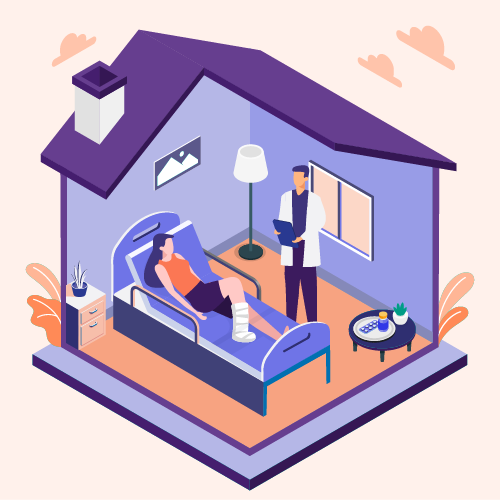How is Technology Impacting Home Healthcare?
In the past, healthcare at home was considered a luxury only few could enjoy. But today with the advancement and availability of technology, we see the era of healthcare digitalization.
Technology has been the main catalyst to drive the evolved ecosystem of not only workspace and home but also the healthcare sector.
Let’s discuss some key statistics to see where the future of home healthcare technology is going?
- According to Grand View Research, the global home healthcare market was valued at USD 281.8 billion in 2019.
- North America dominated globally with a share of around 42% in 2019.
- As per reports, between 2010 and 2050, the senior population is expected to reach 88.5 million, or 20% of the U.S. population, greatly increasing the need for senior healthcare.
- The global home healthcare technology solutions market is expected to grow at a compound annual growth rate (CAGR) of 7.9% from 2020 to 2027.
- According to Home Healthcare Market Scope, in 2020 the market size value is estimated to be USD 303.6 billion.
- Revenue forecast for 2027 is 515.6 billion.
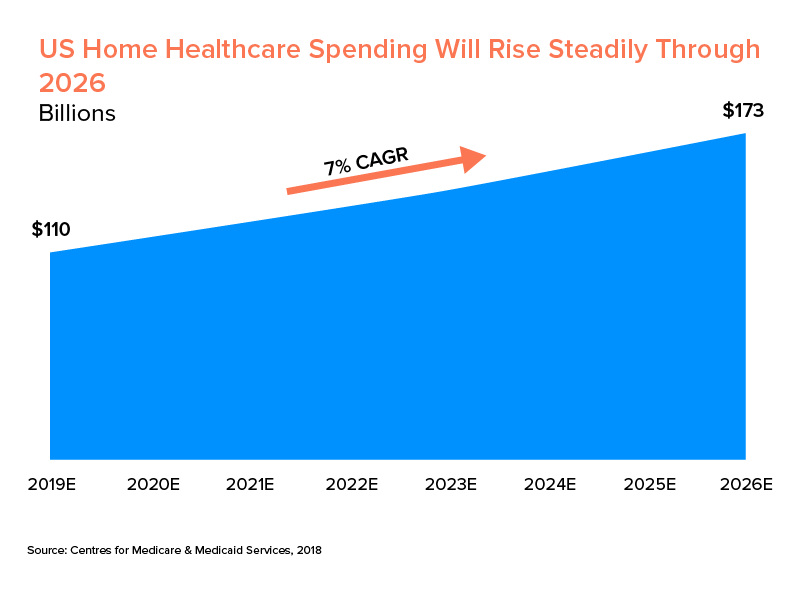
What Does Home Healthcare Entail?
Home care technology comprises professional medical services for a short term or a long term period, at the comfort of your home. Innovations in home health care not only provides services for elderly people or makes senior care efficient, but it also provides services for people with different conditions like, individuals who have special needs or a disability, someone who is aging and needs help to live independently, people recovering from a medical setback, or suffering from chronic diseases, etc.
There are also many apps for home health care services to help the patients provide quick and effective solutions. People can call or take assistance of doctors at their homes with ease. Operating home health care companies and sharing information using technology will become more efficient as agencies and healthcare app developers will move away from paper towards digital records.
Types of home healthcare services:
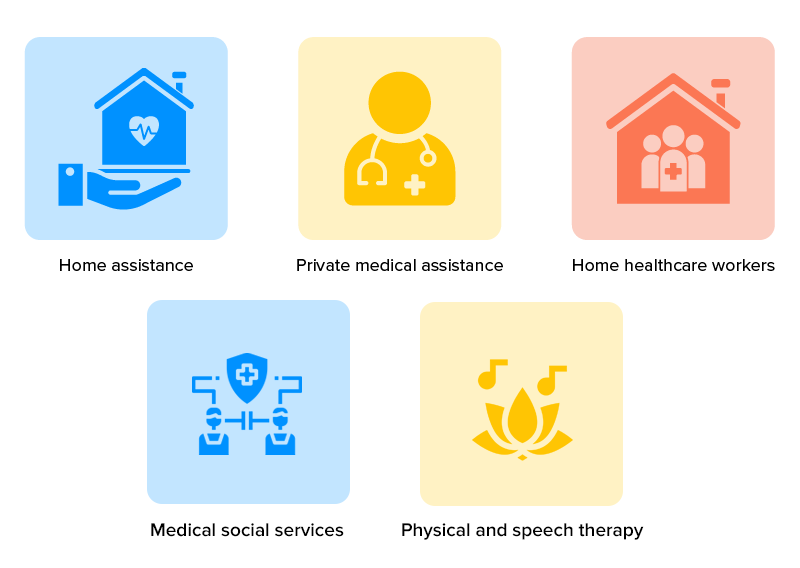
- Home assistance: With medical assistance at home, professional caregivers can help people with activities like bathing, dressing, meal preparation, household tasks, and other daily activities. This helps individuals embrace independence and safety.
- Private medical assistance: It allows individuals to get healthcare at home rather than in a medical facility. It involves medical experts like doctors and nurses to take care of people with chronic illness, special needs or disability, and medical injuries.
- Home healthcare workers: People require home health care like the assistance of a therapist, nutritionist, nurse, or physiotherapist in order to recover from an illness or injury and improve their lifestyle.
- Medical social services: Medical social services offer different types of medical assistance at home to the patient, including counseling and finding community assets to help the patient in their recovery. Some social specialists are likewise the patient’s case manager – in case the patient’s ailment is extremely complex and requires the coordination of many administrations.
- Physical and speech therapy: Some patients might require help relearning how to perform everyday tasks or work on their speech after a sickness or injury. A physical therapist can assemble an arrangement of care to assist a patient with recovering or reinforce the utilization of muscles and joints. A speech therapist can assist a patient with weakened speech recover the capacity to convey clearly.
Technologies Impacting Home Healthcare Ecosystem
The power of technology is revolutionizing home health care solutions and services! Medicines, equipment, and other healthcare requirements can be determined with the help of real-time technology.
The answer to how is technology used in healthcare is mentioned below in points. But you should know that technological advances in home health care have reached a different level! Let’s discuss five technologies that are reforming home health care.
1. Electronic Visit Verification
EVV or electronic visit verification is a technology that helps in verifying caregiver appointments, scheduling, and cancellation, to avoid no-show home appointments. Hence, the service of a home health care personal is electronically verified. It mainly includes:
- The type of service requested by the individual
- Information of the patient
- Information of the home healthcare professional
- Location at which the service is required
- Date when the service is required
- The beginning and end time of the service
2. Remote Patient Monitoring Tools
Home health monitoring devices are the tools or devices that are used to track a patient’s well-being. In today’s world, we have fitness bands that keep a regular track of one’s activities like the number of steps walked, sleep and diet that one had, etc. These innovative applications of wearable tech in healthcare provides individuals the assurance that someone is watching over them and tracking their every move towards a healthy and better lifestyle. These devices can also be connected with smart phones to reduce the cost and time consumed while visiting a doctor.
There are many devices that can also be used to measure blood pressure level, glucose level, heart rate monitoring, and other measurements. RPM allows the caregivers, doctors, patients, and their families to track their healthcare needs and eliminate risks as well as regular doctor visits.
3. Virtual Reality
VR technology is helping both patients and doctors. Virtual reality is now used for training healthcare professionals in a more realistic and low-risk environment. It also helps in building the age gap between young doctors and elderly patients. This way, medical professionals get a chance to increase their capabilities.
When it comes to physical and mental health, virtual reality technology offers therapeutic potential. It helps in rehabilitation and healing for anxiety disorders and severe pain. According to the ABI Research, VR services in the medical and home health technology segment is about to explode in value from $8.9 million in 2017 to around $285 million in 2022.
4. Internet of Medical Things (IoMT)
Health information technology, medical services, devices, and data constitute the internet of medical things or IoMT. According to Deloitte, the IoMT will be worth $158.1 billion by 2022. Few advantages of IoMT for both, medical professionals and patients are listed below:
- It reduces the room for mistakes.
- The intake and effect of medicines can be monitored.
- Digital therapy can be used to minimize pain such as acupuncture, massages, etc.
- Biofeedback systems can help caregivers track heart rate, temperature, glucose, blood pressure, etc.
5. Telehealth
Virtual home healthcare technology like telehealth or telemedicine, allows consumers to get in touch with medical caregivers with the help of technology. By using mobile apps or video conferencing, doctors and nurses are just a finger touch away. Let’s discuss a few more benefits of medical technology:
- Telehealth is a great way to avoid traveling to-and-fro for disabled and elderly patients.
- It allows doctors to examine patients anywhere, anytime, and share the outcomes in real time.
- It also makes the remote patient monitoring (RPM) process easier for the medical professionals since they can check-in on the patient in non-emergency situations as well.
6. Blockchain
It is said that blockchain will revolutionize the healthcare industry. Home health care is mainly dependent on huge data from various resources. The data requires extensive analysis to gain crucial insights for the apt treatment required. Below are a few advantages of blockchain in healthcare:
- It can easily help verify and manage patient’s medical data.
- Blockchain can be used for online payments and for the elimination of security issues.
- The integration of blockchain and healthcare can also be used in clinical research and drug development. It can be used to maintain data of trial patients, manage and keep a track of documentation, and reduce falsification of results.
7. Healthcare chatbots
This AI-powered technology can be leveraged to provide automated interactions with patients during critical times. These healthcare chatbots when integrated with medical information like symptoms, medications, treatments, doctors, conditions, etc can be a time savior. The questions in such chatbots revolve around the type of injury and level of pain; this information further gets recorded for caregivers to follow up with patients.
8. Electronic Health Records
The power of artificial intelligence helps save the valuable time of medical professionals! You must be thinking how is that possible? Well, AI in health sector automates several manual tasks such as: observing the patient constantly and recording the same. It also reports if there is any suspicious activity and requires immediate professional attention. This advancement in technology helps medical professionals focus on critical patients and eliminate the risks.
9. GPS
In situations of crisis, for example, when senior and old age individuals are away from home for quite a while, GPS tracking can help their families, health workers, or law implementation bodies to find them rapidly. Technologies with components, for example, mobile alarm benefits likewise permit these gadgets to follow a hybrid approach that empowers individuals to track down the old even in places where GPS probably won’t be accessible, for example, garage parking and so on. It can likewise help via automated calling for help in case there is an emergency. GPS becomes the necessary choice in emergency business service.
10. Wearable Technology
Creative wearable is another technology in home healthcare innovation that is providing steady confirmation and medical assistance at home to the patients. With AI in werable technology, a medical expert looks after the patient and follows their vitals towards a sound and healthy way of life. These connectable gadgets additionally diminish the expense and the time burned through while visiting a healthcare facility.
Challenges of Technology Integration in Home Healthcare
On one hand, technology has a positive impact on home healthcare services but on the other hand, it also presents some unique challenges. Some of those issues with technology in home healthcare includes:
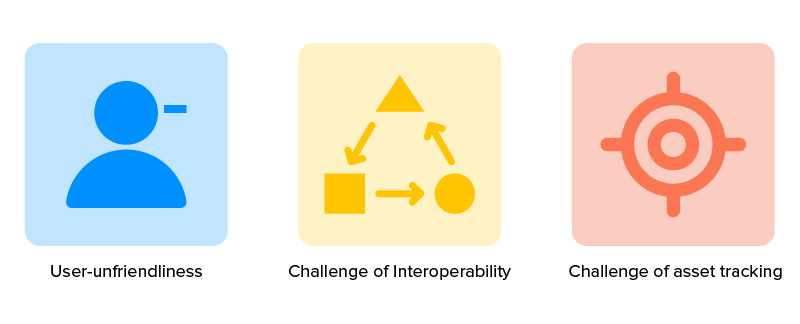
a) User-unfriendliness: While technology is constantly innovating healthcare, it is not of any significance if it is too difficult to use! Problems in user interface such as, too much data and improper navigation does not contribute to a good user experience.
Solution: This challenge can be knocked off by hiring the right team of healthcare developers who will make sure that the user-interface is user friendly and easy to navigate. They can even integrate a step by step navigation of the app to enhance the user-experience.
b) Challenge of Interoperability: Interoperability is the ability of a system to access, exchange, and integrate the data of a particular patient. This becomes a challenge when a patient’s information cannot be tracked with the right EHRs (Electronic Health Records).
Solution: The challenge of interoperability can be avoided if we implement cloud-based solutions. Cloud-based EHRs will not only be safe but also provide a centralized database.
c) Challenge of asset tracking: Medical professionals often complain that tracking the medical history and health reports are time consuming and causes delay in their work. Further, it makes them ‘a slave to EHRs’.
Solution: Since EHRs are a crucial part of home health care, they can’t be avoided. The healthcare software developer should give caregivers a proper training on how to use the technology without wasting their time.
Harmony Between Age Demographics and Home Healthcare
In today’s world, there has been a drastic change in the number of individuals seeking medical assistance at home. It is estimated that approximately 12 million people are receiving home healthcare.
As per the reports by Deloitte, the Internet of Medical Things (IoMT) market is estimated to be worth $158.1 billion by 2022.
The continuously evolving home health care technology is being accelerated by the rapidly changing age demographic. The use of technology in the health sector is also fueling investor excitement in this industry.
According to Statista, in 2017, about 16% of the American population was 65 years old or more. These figures are expected to reach 22% by 2050. This is a significant increase from 1950, when only eight percent of the population was 65 or over. Now, keeping the statistics in mind, the need of the hour is to develop home health care solutions according to people’s expectations and needs!
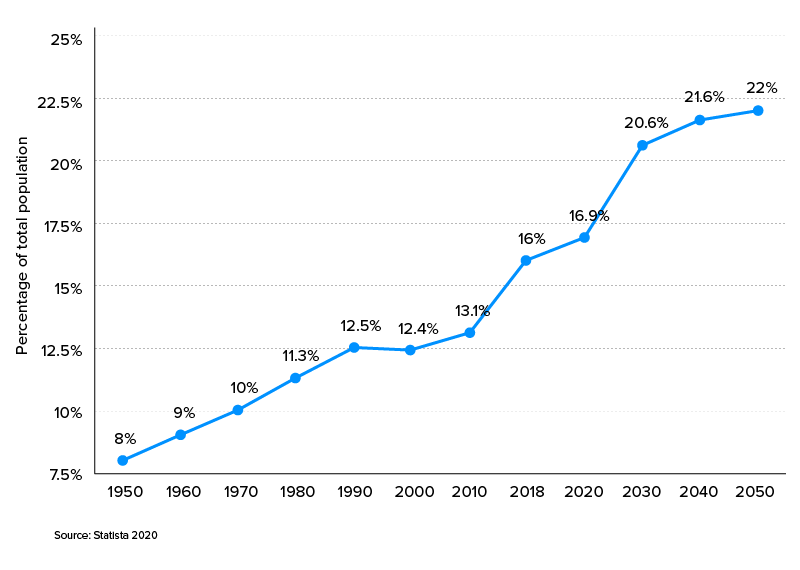
The numbers do not lie and looking at the above data, we can say that if you are aspiring for healthcare application development, the time is now! We cannot only help you turn your healthcare system into a digital health leader but also turn healthcare consumerism challenges into an opportunity.
Winding Up
Healthcare at home is transforming healthcare right now but it can be leveraged if you make sure to hire the right healthcare app development company who masters in healthcare software development and healthcare mobile app development. This way, the technologies can be utilized in an effective way. We need to believe in the benefits of medical technology in order to put them in the best use possible for patients, doctors, nurses and other healthcare professionals! The new healthcare ecosystem is awaiting, are you ready to embrace it?

strategies your digital product..
